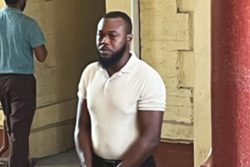Home Affairs Minster Clement Rohee yesterday handed over a water cannon to the police force and he dismissed concerns that its arrival was intended to intimidate the public ahead of the upcoming elections.
Speaking at the handing over ceremony, Rohee stated that the timing of its arrival ahead of the November 28 elections is a mere coincidence. “We have no control over the shipping arrangements and we certainly did not indicate to the shippers or to the manufacturers that they should ship it to coincide with elections in Guyana. It’s merely a matter of a coincidence… There’s no anticipation that this will be used during elections,” he assured.
Rohee emphasised that the presence of the cannon should not be seen as anything political. “Obviously the politicians will seek to politicise the arrival of this machine in the country. I do not think that is necessary. A modern police force requires this vehicle and it is our view that they should be provided with such a vehicle. And, therefore, I don’t think there is any need to politicise the arrival of this vehicle or the handing over, or the possession of this vehicle in the Guyana police force,” he said, while noting that too often the government has been accused of not doing enough to modernise institutions such as the police force.
While reiterating that the vehicle is not meant to be a threat to the public, Rohee added that there is no need for anyone to fear its presence. “It is only those who will seek to disrupt the peace, and do so in an unlawful way, that they should fear this vehicle. Once you stand by the law, once you do everything in keeping with the law, then there’s no need to fear a vehicle or those who will be using this vehicle,” he said.
Making reference to the increasing modernisation of police forces the world over, the minister stated that the local force should also be equipped with modern amenities required for maintaining law and order, and the water cannon is one such tool. He pointed out that “this modernisation cannot only be seen in the context of the human resources, [or] the institutional capacity, [and] the technological capacity; it must also be seen in the context of the capacity of the organisation to maintain public order in our country,” and added “we cannot only talk modernisation, we have to do modernisation.”
When questioned about the source of the funding for the cannon, Rohee noted that “this was in the budget.” He declined, however, to detail the cost, stating that “it’s a couple million dollars.” In its 2010 budget, government had announced plans to spend $37M on a water cannon.
Meanwhile, questioned about the non-working fire hydrants across the country and whether the situation would affect the operation of the cannon, Rohee stated that the vehicle does not necessarily have to rely on fire hydrants for it to operate. Instead, he said, it will fulfil its responsibility until there is the capacity to switch to the hydrants, “but I don’t necessarily see a correlation between non-functioning fire hydrants and a vehicle costing so many millions of dollars. Then the logic of that would be that we don’t have fire hydrants working.”
Georgetown Mayor Hamilton Green, in a letter published in Stabroek News on Monday, criticised the investment in the cannon while the city and its environs have useless fire hydrants. Concerns about the non-functioning hydrants and deficiencies in the fire service’s equipment were sounded when government announced plans to purchase the cannon last year. Rohee had said then that the fire service depended on water providers for water. “As far as I am aware the Guyana Fire Service was never the agency to get water into the hydrants,” he had said, while also maintaining that despite holes in hoses from time to time, the service did not “have a problem with equipment.”
The cannon was officially handed over by Rohee at the Tactical Services Unit Drill Square, at Police Headquar-ters, Eve Leary, where it was test-driven by ranks.
In accepting what he called vital equipment, Commis-sioner of Police Henry Greene explained that part of the force’s strategy in maintaining public order and preserving peace is through the use of minimum force. The water cannon, he said, is just the equipment for non-lethal force. “The water cannon is intended to be used in environments where there’s crowd disorder, things are totally out of control and there’s need for the police to bring back some semblance of order,” he explained.
Greene noted that a few years back, during a riot on Regent Street, the force had to resort to assistance from a Guyana Fire Service vehicle for crowd control.








